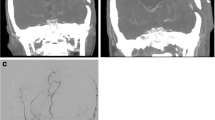Abstract
Background
Combined bypass, including direct and indirect procedures, has been recognized as the maximal revascularization to prevent further hemorrhagic or ischemic stroke in adult moyamoya disease (MMD). It is also important to consider cosmetic aspects when planning combined bypass for MMD. However, there are few reports that have described the cosmetic considerations in bypass surgery for MMD.
Methods
We demonstrate our surgical techniques aimed at achieving extended revascularization as well as excellent cosmetic outcomes with figures and video.
Conclusion
Our combined bypass procedures which focus on achieving maximal cosmetic results are effective methods that require no special instruments or techniques.

Similar content being viewed by others
References
Egashira Y, Yamauchi K, Enomoto Y, Nakayama N, Yoshimura S, Iwama T (2017) Disruption of cortical arterial network is associated with the severity of transient neurologic events after direct bypass surgery in adult moyamoya disease. World Neurosurg 100:311–315. https://doi.org/10.1016/j.wneu.2017.01.039
Houkin K, Kuroda S, Ishikawa T, Abe H (2000) Neovascularization (angiogenesis) after revascularization in moyamoya disease. Which technique is most useful for moyamoya disease? Acta Neurochir (Wien) 142:269–276. https://doi.org/10.1007/s007010050035
Iwama T, Hashimoto N, Yonekawa Y (1996) The relevance of hemodynamic factors to perioperative ischemic complications in childhood moyamoya disease. Neurosurgery 38:1120–1125; discussion 1125-1126. https://doi.org/10.1097/00006123-199606000-00011
Nguyen VN, Motiwala M, Elarjani T, Moore KA, Miller LE, Barats M, Goyal N, Elijovich L, Klimo P, Hoit DA, Arthur AS, Morcos JJ, Khan NR (2022) Direct, indirect, and combined extracranial-to-intracranial bypass for adult moyamoya disease: an updated systematic review and meta-analysis. Stroke. https://doi.org/10.1161/STROKEAHA.122.039584
Noguchi K, Aoki T, Orito K, Kajiwara S, Fujimori K, Morioka M (2018) Novel indirect revascularization technique with preservation of temporal muscle function for moyamoya disease encephalo-duro-fascio-arterio-pericranial-synangiosis: a case series and technical note. World Neurosurg 120:168–175. https://doi.org/10.1016/j.wneu.2018.08.171
Oikawa S, Mizuno M, Muraoka S, Kobayashi S (1996) Retrograde dissection of the temporalis muscle preventing muscle atrophy for pterional craniotomy. Technical note. J Neurosurg 84:297–299. https://doi.org/10.3171/jns.1996.84.2.0297
Rennert RC, Budohoski KP, Grandhi R, Couldwell WT (2022) Combined direct and indirect superficial temporal artery-to-middle cerebral artery bypass with a hinged bone flap: how I do it. Acta Neurochir (Wien) 164:3203–3208. https://doi.org/10.1007/s00701-022-05393-6
Suetake K, Uede T, Momota H, Oka S, Piao H, Minamida Y, Hashi K (1999) Usefulness of galea suturing method for scalp closure. No Shinkei Geka 27:427–430
Uchino H, Nakayama N, Kazumata K, Kuroda S, Houkin K (2016) Edaravone reduces hyperperfusion-related neurological deficits in adult moyamoya disease: historical control study. Stroke 47:1930–1932. https://doi.org/10.1161/STROKEAHA.116.013304
Author information
Authors and Affiliations
Contributions
All authors contributed to the study conception and design. Material preparation, data collection, and analysis were performed by YE, YE, and KK. The first draft of the manuscript was written by YE, and all authors commented on previous versions of the manuscript. All authors read and approved the final manuscript.
Corresponding author
Ethics declarations
Ethical approval
Official approval from the institutional review board is waived for case presentation. All procedures employed in the present study are in accordance with the ethical standards of the Gifu University Hospital and with the 1964 Helsinki Declaration and its later amendments. The patient consented to the publication of his case in the present study.
Conflict of interest
The authors declare no competing interests.
Additional information
Publisher’s note
Springer Nature remains neutral with regard to jurisdictional claims in published maps and institutional affiliations.
Supplementary information
The online version contains supplementary material available online.
Rights and permissions
Springer Nature or its licensor (e.g. a society or other partner) holds exclusive rights to this article under a publishing agreement with the author(s) or other rightsholder(s); author self-archiving of the accepted manuscript version of this article is solely governed by the terms of such publishing agreement and applicable law.
About this article
Cite this article
Egashira, Y., Enomoto, Y., Kano, K. et al. How I do it: combined bypass for adult moyamoya disease with maximal consideration of cosmetic aspects. Acta Neurochir 165, 2073–2076 (2023). https://doi.org/10.1007/s00701-023-05604-8
Received:
Accepted:
Published:
Issue Date:
DOI: https://doi.org/10.1007/s00701-023-05604-8




